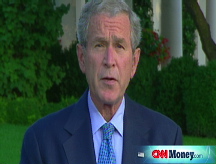What got killed
The fate of the most sweeping government rescue since the Great Depression is in doubt after the House voted against it Monday. Here's what was in the package.
NEW YORK (CNNMoney.com) -- In the span of just 11 days, the Bush administration and lawmakers, seeing ominous warnings in the credit markets, rushed to create legislation to prevent a potential economic meltdown. Monday, the resulting $700 billion bailout package was defeated in a dramatic House vote.
The bill was designed to get financial institutions lending again by letting the U.S. Treasury buy up their troubled assets, most of which are tied to the housing market crash.
But after much contentious debate, and the addition of several taxpayer protections, the package was rejected by the House in a vote that was 228 to 205 against. The measure would have needed 218 votes for the House to pass. The next steps were not immediately clear but supporters were scrambling to put it up for another vote.
"I'm disappointed," said House Financial Services Chairman Barney Frank, D-Mass., talking to reporters after the vote. Noting that the Administration painted a dire picture of economic calamity if legislation didn't pass, Frank said, "I'd like nothing better than to be proven wrong in the next few days. I was persuaded that we have a serious crisis and we're threatened with a shutdown of the credit system when the economy is already weakened."
The credit markets had been seized up all day Monday, and after the vote, the Dow Jones Industrial Average started to plummet and ended the day down 778 points, the worst point drop ever. On a percentage basis, though, the Dow drop was only about 7%, far less than the 22% slide on Black Monday in 1987.
Here's a quick breakdown of some of the bill's key provisions:
Doling the money out: The $700 billion would be disbursed in stages, with $250 billion made available immediately for the Treasury's use. Authority to use the money would expire on Dec. 31, 2009, unless Congress certifies a one-year extension.
Protecting taxpayers: The ultimate cost to the taxpayer is not expected to be near the amount the Treasury invests in the program. That's because the government would buy assets that have underlying value.
If the Treasury pays fair market value - which investors have had a hard time determining - taxpayers stand a chance to break even or even make a profit if those assets throw off income or appreciate in value by the time the government sells them. If it overpays for the assets, the government could be left with a net loss but would get something back on the open market for the assets when it eventually sells them.
If it ends up with a net loss, however, the bill says the president must propose legislation to recoup money from the financial industry if the rescue plan results in net losses to taxpayers five years after the plan is enacted.
In addition, Treasury would be allowed to take ownership stakes in participating companies.
Stemming foreclosures: The bill calls for the government, as an owner of a large number of mortgage securities, to exert influence on loan servicers to modify more troubled loans.
In cases where the government buys troubled mortgage loans directly from banks, it can adjust them more easily.
Limiting executive pay: Curbs would be placed on the compensation of executives at companies that sell mortgage assets to the Treasury. Among them, companies that participate will not be able to deduct the salary they pay to executives above $500,000.
They also will not be allowed to write new contracts that allow for "golden parachutes" for their top 5 executives if they are fired or the company goes belly up. But the executives' current contracts, which may include golden parachutes, would still stand.
Overseeing the program: The bill would establish two oversight boards.
The Financial Stability Oversight Board would be charged with ensuring the policies implemented protect taxpayers and are in the economic interests of the United States. It will include the Federal Reserve chairman, the Securities and Exchange Commission chairman, the Federal Home Finance Agency director, the Housing and Urban Development secretary and the Treasury secretary.
A congressional oversight panel would be charged with reviewing the state of financial markets, the regulatory system and the Treasury's use of its authority under the rescue plan. Sitting on the panel would be 5 outside experts appointed by House and Senate leaders.
Insuring against losses: Treasury must establish an insurance program - with risk-based premiums paid by the industry - to guarantee companies' troubled assets, including mortgage-backed securities, purchased before March 14, 2008.
The amount the Treasury would spend to cover losses minus company-paid premiums would come out of the $700 billion the Treasury is allowed to use for the rescue plan. ![]()



